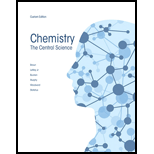
CHEMISTRY:CENTRAL SCI.-W/ACCESS>CUSTOM<
15th Edition
ISBN: 9781323233252
Author: Brown
Publisher: PEARSON C
expand_more
expand_more
format_list_bulleted
Question
Chapter 7.3, Problem 7.2.1PE
(b)
Interpretation Introduction
To determine: The activity of the sample in Bq.
Expert Solution & Answer
Want to see the full answer?
Check out a sample textbook solution
Students have asked these similar questions
please help with hw
help me solve this hw
help me solve this hw
Chapter 7 Solutions
CHEMISTRY:CENTRAL SCI.-W/ACCESS>CUSTOM<
Ch. 7.3 - Prob. 7.1.1PECh. 7.3 - Prob. 7.1.2PECh. 7.3 - Prob. 7.2.1PECh. 7.3 - Prob. 7.2.2PECh. 7.3 - Prob. 7.3.1PECh. 7.3 - Prob. 7.3.2PECh. 7.3 - Prob. 7.4.1PECh. 7.3 - Prob. 7.4.2PECh. 7.4 - Prob. 7.5.1PECh. 7.4 - Prob. 7.5.2PE
Ch. 7.4 - Prob. 7.6.1PECh. 7.4 - The atomic masses of hydrogen-2 (deuterium),...Ch. 7.4 - Prob. 7.7.1PECh. 7.4 - Prob. 7.7.2PECh. 7.6 - Prob. 7.8.1PECh. 7.6 - Prob. 7.8.2PECh. 7.6 - Prob. 7.9.1PECh. 7.6 - Prob. 7.9.2PECh. 7.7 - Prob. 7.10.1PECh. 7.7 - Prob. 7.10.2PECh. 7 - Prob. 1DECh. 7 - Prob. 1ECh. 7 - Prob. 2ECh. 7 - Prob. 3ECh. 7 - Prob. 4ECh. 7 - Prob. 5ECh. 7 - Prob. 6ECh. 7 - Prob. 7ECh. 7 - Prob. 8ECh. 7 - Prob. 9ECh. 7 - Prob. 10ECh. 7 - You might have expected that the elements would...Ch. 7 - Prob. 12ECh. 7 - (a) What is meant by the term effective nuclear...Ch. 7 - Prob. 14ECh. 7 - Prob. 15ECh. 7 - Prob. 16ECh. 7 - Prob. 17ECh. 7 - Prob. 18ECh. 7 - Prob. 19ECh. 7 - Why does the quantum mechanical description or...Ch. 7 - Prob. 21ECh. 7 - Prob. 22ECh. 7 - Prob. 23ECh. 7 - Prob. 24ECh. 7 - Prob. 25ECh. 7 - Prob. 26ECh. 7 - Prob. 27ECh. 7 - Prob. 28ECh. 7 - Prob. 29ECh. 7 - Prob. 30ECh. 7 - Prob. 31ECh. 7 - Prob. 32ECh. 7 - Prob. 33ECh. 7 - Prob. 34ECh. 7 - Prob. 35ECh. 7 - In the ionic compounds LiF, NaCl, KBr, and RbI,...Ch. 7 - Prob. 37ECh. 7 - Prob. 38ECh. 7 - Prob. 39ECh. 7 - Prob. 40ECh. 7 - Prob. 41ECh. 7 - Prob. 42ECh. 7 - Prob. 43ECh. 7 - Prob. 44ECh. 7 - Prob. 45ECh. 7 - Prob. 46ECh. 7 - Prob. 47ECh. 7 - Prob. 48ECh. 7 - Prob. 49ECh. 7 - Prob. 50ECh. 7 - 7.51 Although the electron affinity ofbromineis a...Ch. 7 - Prob. 52ECh. 7 - Prob. 53ECh. 7 - Prob. 54ECh. 7 - Prob. 55ECh. 7 - Prob. 56ECh. 7 - Prob. 57ECh. 7 - Prob. 58ECh. 7 - Prob. 59ECh. 7 - Prob. 60ECh. 7 - Prob. 61ECh. 7 - Prob. 62ECh. 7 - Prob. 63ECh. 7 - Prob. 64ECh. 7 - Prob. 65ECh. 7 - Why does xenon form stable compounds with...Ch. 7 - Prob. 67ECh. 7 - Prob. 68ECh. 7 - Prob. 69ECh. 7 - Prob. 70ECh. 7 - Prob. 71ECh. 7 - Prob. 72ECh. 7 - Prob. 73ECh. 7 - Prob. 74ECh. 7 - Prob. 75ECh. 7 - Prob. 76ECh. 7 - Prob. 77ECh. 7 - Prob. 78ECh. 7 - Prob. 79AECh. 7 - Prob. 80AECh. 7 - Prob. 81AECh. 7 - Prob. 82AECh. 7 - Prob. 83AECh. 7 - Prob. 84AECh. 7 - Prob. 85AECh. 7 - Prob. 86AECh. 7 - Prob. 87AECh. 7 - Prob. 88AECh. 7 - Prob. 89AECh. 7 - Prob. 90AECh. 7 - Prob. 91AECh. 7 - Write a chemical formula for each compound or ion,...Ch. 7 - Prob. 93AECh. 7 - Prob. 94AECh. 7 - Prob. 95AECh. 7 - Prob. 96AECh. 7 - Prob. 97AECh. 7 - Prob. 98AECh. 7 - Prob. 99AECh. 7 - Prob. 100AECh. 7 - Prob. 101AECh. 7 - Prob. 102AECh. 7 - Prob. 103AECh. 7 - Prob. 104AECh. 7 - Prob. 105AECh. 7 - Prob. 106AECh. 7 - Prob. 107AECh. 7 - Prob. 108AECh. 7 - Prob. 109AECh. 7 - Prob. 110IECh. 7 - Prob. 111IECh. 7 - Prob. 112IECh. 7 - Prob. 113IECh. 7 - Prob. 114IECh. 7 - Prob. 115IE
Knowledge Booster
Similar questions
- Reason whether it is possible to determine changes in the Galvani potential difference at the metal-solution interface.arrow_forwardObtain the standard potential at 25°C of the Cu* I Cu | Pt electrode from the standard potentials E° Cu²+/Cu = 0.341 V and E Cu²+ /Cu+ = 0.153 V.arrow_forwardIn electrochemistry, briefly describe the Galvani potential, the Volta potential, and the surface potential. Differentiate between them.arrow_forward
arrow_back_ios
SEE MORE QUESTIONS
arrow_forward_ios
Recommended textbooks for you
 ChemistryChemistryISBN:9781305957404Author:Steven S. Zumdahl, Susan A. Zumdahl, Donald J. DeCostePublisher:Cengage Learning
ChemistryChemistryISBN:9781305957404Author:Steven S. Zumdahl, Susan A. Zumdahl, Donald J. DeCostePublisher:Cengage Learning ChemistryChemistryISBN:9781259911156Author:Raymond Chang Dr., Jason Overby ProfessorPublisher:McGraw-Hill Education
ChemistryChemistryISBN:9781259911156Author:Raymond Chang Dr., Jason Overby ProfessorPublisher:McGraw-Hill Education Principles of Instrumental AnalysisChemistryISBN:9781305577213Author:Douglas A. Skoog, F. James Holler, Stanley R. CrouchPublisher:Cengage Learning
Principles of Instrumental AnalysisChemistryISBN:9781305577213Author:Douglas A. Skoog, F. James Holler, Stanley R. CrouchPublisher:Cengage Learning Organic ChemistryChemistryISBN:9780078021558Author:Janice Gorzynski Smith Dr.Publisher:McGraw-Hill Education
Organic ChemistryChemistryISBN:9780078021558Author:Janice Gorzynski Smith Dr.Publisher:McGraw-Hill Education Chemistry: Principles and ReactionsChemistryISBN:9781305079373Author:William L. Masterton, Cecile N. HurleyPublisher:Cengage Learning
Chemistry: Principles and ReactionsChemistryISBN:9781305079373Author:William L. Masterton, Cecile N. HurleyPublisher:Cengage Learning Elementary Principles of Chemical Processes, Bind...ChemistryISBN:9781118431221Author:Richard M. Felder, Ronald W. Rousseau, Lisa G. BullardPublisher:WILEY
Elementary Principles of Chemical Processes, Bind...ChemistryISBN:9781118431221Author:Richard M. Felder, Ronald W. Rousseau, Lisa G. BullardPublisher:WILEY

Chemistry
Chemistry
ISBN:9781305957404
Author:Steven S. Zumdahl, Susan A. Zumdahl, Donald J. DeCoste
Publisher:Cengage Learning

Chemistry
Chemistry
ISBN:9781259911156
Author:Raymond Chang Dr., Jason Overby Professor
Publisher:McGraw-Hill Education

Principles of Instrumental Analysis
Chemistry
ISBN:9781305577213
Author:Douglas A. Skoog, F. James Holler, Stanley R. Crouch
Publisher:Cengage Learning

Organic Chemistry
Chemistry
ISBN:9780078021558
Author:Janice Gorzynski Smith Dr.
Publisher:McGraw-Hill Education

Chemistry: Principles and Reactions
Chemistry
ISBN:9781305079373
Author:William L. Masterton, Cecile N. Hurley
Publisher:Cengage Learning

Elementary Principles of Chemical Processes, Bind...
Chemistry
ISBN:9781118431221
Author:Richard M. Felder, Ronald W. Rousseau, Lisa G. Bullard
Publisher:WILEY